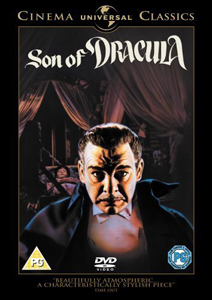What is “Son of Dracula” (1943) about? It is a black-and-white horror flick that concerns a Southern belle aiming for immortality – and also, a better boyfriend.
It’s about a beautiful girl who can’t stop thinking about the occult, living forever and finding the right kind of guy — a more exotic guy, ideally. It’s also a film about vampirism. Because that’s what you get when you abandon an American-grown boy for a foreigner with a cape. That’s the moral of the story.
Now, when you combine all of those objectives, themes and elements, it’s going to get messy. But it holds it all together. This is a little-watched flick, but it’s worth seeing.

“Son of Dracula” (1943)
Director: Robert Siodmak
Writers: Robert Siodmak, Eric Taylor
Stars: Lon Chaney Jr., Louise Allbritton, Robert Paige
Can Count Dracula’s kid make it in America?
Count Alucard is an immigrant from Budapest. He eats neither dogs (nor hotdogs, insofar as the film reveals) nor cats. As a result, his visa is quickly approved at the U.S. border, whereupon he arranges for transportation to Dark Oaks, a plantation surrounded by cypress trees, disenfranchised former slaves and fog.
He arrives almost unnoticed. Surprisingly, no one even bothers to try to spell his name backward, despite the fact that it makes almost no sense at all frontward.
Meanwhile, Katherine (Louise Allbritton) – a nubile, confused, statuesque, attractive heiress with a Southern drawl – strolls onto the stage, notices Count Alucard, and promptly invites the bachelor into her home. Her current (rather dull) boyfriend is wary of the newcomer-foreigner-competitor played by Lon Chaney Jr. Said upright boyfriend is justified in his suspicions because the fleshy and exotic Count Alucard is none other than the suave son of Count Dracula.
(Cue dramatic organ chords!)
It sounds like we’ve got the makings of a love triangle.
A love triangle – with fangs!
A large part of what makes the original blockbuster “Dracula” (1931) so effective is the love triangle between John Harker (the lawyer), Mina Murray (his fiancé) and the new guy with the accent and gleaming teeth played by the riveting Bela Lugosi. Bela nailed it, he really did. No one can compete with Bela. Besides, generally speaking, very few men can compete with a bad boy with an accent and a widow’s peak.
Lugosi had been working the role of the bloodsucking interloper on Broadway; that helped. He’d refined his approach and figured out all the angles in the theatrical production. Then, on film, he got to do so in Tod Browning’s freakish style.
No wonder “Dracula” rocked. And still does today.
Love triangles recur so frequently in film and fiction because of their effectiveness in portraying conflict and injecting narrative momentum. The same idea is replicated in “Twilight” (2008) and its sequels (though not horror films – they’re barely even films!). But the point is that love triangles drive a plot with the momentum of a NASCAR race. And that’s one reason this film works.

The guest-host hook
A secondary aspect of the narrative potency of “Dracula” is the way it inverts the guest-host dynamic. In the original film, initially, innocent lawyer Harker is a guest of Dracula’s. Later, Dracula moves in next door to Harker in England.
The viewer is taught that the vampire cannot do his nastiness unless he’s invited. These tropes upend the guest-host relationship – first the guest-lawyer is plying for fees from his host, then countries flip, and the former-host-now-guest is revealed to be a vampire, petitioning his Brit-host for an invite.
Then there’s a pair of fangs at the host’s throat. And that of his fiancée. And Lucy Westerna’s, too. There’s also an evil-immigrant subject muddying the pretext of the whole plot. (We still suffer from the paranoia that immigrants are, if not biting our maidens, then eating our pets.) The unstated premise is that horrific catastrophe flows from liberal immigration policies.
Released more than a decade after its blockbuster precursor, “Son of Dracula” implicitly recognizes that it would be cheating to simply bring the eponymous Romanian back to life for a “Dracula II” role. (There never was a film titled as such, and by the time everyone got around to making “Son of Dracula,” Lugosi was slipping into heroin-land, making him unemployable, as related in 1994’s “Ed Wood.”
Swapping out the stuffy English setting for an American one and introducing all new characters, the film nevertheless adheres to the same love triangle and inverted guest-host formulas. But in a good way. It’s genuinely watchable.
The cast
Professor Lazlo (J. Edward Bromberg) is the stand-in for Abraham Van Helsing. As a scientist, Lazlo is not of the same intellect as Professor Van Helsing, but Lazlo alone is clever enough to adduce that “Alucard” is “Dracula” spelled backward, which is proof enough of his family connections to Van Helsing, especially if one also factors in the bite marks and bats.
The casting of Chaney Jr. as the son of Dracula has a special resonance. Chaney Jr. was the biological son of easily the greatest character actor of all time, Leonidas Frank Chaney – the “man of a thousand faces” (see James Cagney impersonating the great star in 1957’s “Man of a Thousand Faces”) and the grotesque star of “The Phantom of the Opera” (1925).
Better known as Lon Chaney Sr., he died an untimely death from throat cancer at 47 in 1930 when his son (best known for his role as the cursed Lawrence Talbot in 1941’s “The Wolfman”) was in his early 20s. For Lon Jr. to take up the mantle of his father in a role of the son of Lugosi’s greatest role is especially touching. Lon Jr.’s performance would have made his dad proud.
But is it really worth viewing?
Lon Chaney Jr. fans unite! Yes. Undoubtedly. It is worth a watch.
Admittedly, “Son of Dracula” plays second fiddle to “Dracula” and even “Dracula’s Daughter” (1936), the direct sequel to “Dracula.” But that is like saying an individual measured against Winston Churchill and Mother Teresa comes in third place.
“Son of Dracula” conveys a genuinely haunting mood that few modern color films can match. Spooky, occasionally humorous, and more than mildly interesting, it’s worth your time.

